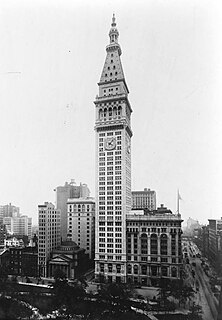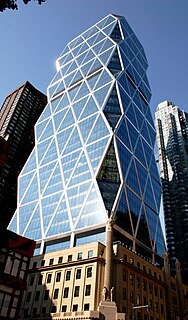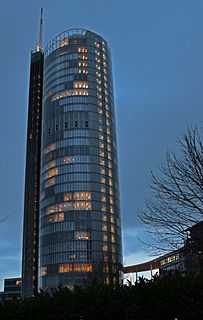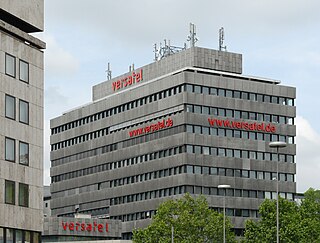| Tagblatt-Turm | |
|---|---|
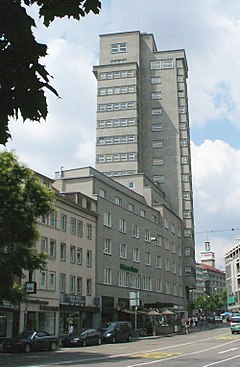 | |
| General information | |
| Type | Commercial offices |
| Architectural style | Early Modernism |
| Location | Eberhardstraße 61 Stuttgart, Germany |
| Coordinates | 48°46′22″N9°10′34″E / 48.77278°N 9.17611°E Coordinates: 48°46′22″N9°10′34″E / 48.77278°N 9.17611°E |
| Completed | 1924-1928 |
| Height | |
| Roof | 61 m (200 ft) |
| Technical details | |
| Floor count | 16 |
| Design and construction | |
| Architect | Ernst Otto Osswald |
| Main contractor | Kübler AG |
| References | |
| [1] [2] [3] | |
Tagblatt-Turm (English: Daily Newspaper Tower) is a 61 m (200 ft), the 16-storey skyscraper in Stuttgart, Baden-Württemberg, Germany.

Stuttgart is the capital and largest city of the German state of Baden-Württemberg. Stuttgart is located on the Neckar river in a fertile valley known locally as the "Stuttgart Cauldron." It lies an hour from the Swabian Jura and the Black Forest. Its urban area has a population of 609,219, making it the sixth largest city in Germany. 2.7 million people live in the city's administrative region and another 5.3 million people in its metropolitan area, making it the fourth largest metropolitan area in Germany. The city and metropolitan area are consistently ranked among the top 20 European metropolitan areas by GDP; Mercer listed Stuttgart as 21st on its 2015 list of cities by quality of living, innovation agency 2thinknow ranked the city 24th globally out of 442 cities and the Globalization and World Cities Research Network ranked the city as a Beta-status world city in their 2014 survey.
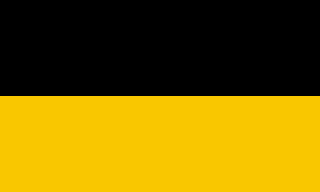
Baden-Württemberg is a state in southwest Germany, east of the Rhine, which forms the border with France. It is Germany’s third-largest state, with an area of 35,751 km2 (13,804 sq mi) and 11 million inhabitants. Baden-Württemberg is a parliamentary republic and partly sovereign, federated state which was formed in 1952 by a merger of the states of Württemberg-Baden, Baden and Württemberg-Hohenzollern. The largest city in Baden-Württemberg is the state capital of Stuttgart, followed by Karlsruhe and Mannheim. Other cities are Freiburg im Breisgau, Heidelberg, Heilbronn, Pforzheim, Reutlingen and Ulm.

Germany, officially the Federal Republic of Germany, is a country in Central and Western Europe, lying between the Baltic and North Seas to the north, and the Alps to the south. It borders Denmark to the north, Poland and the Czech Republic to the east, Austria and Switzerland to the south, France to the southwest, and Luxembourg, Belgium and the Netherlands to the west.
Contents
The landmark Tagblatt-Turm was designed by architect Ernst Otto Oßwald, and is one of Germany's earliest high-rises, constructed between 1924 and 1928 and made from crushed stone and cement. It was the tallest building in the city after the old 1905 city hall, and the highest office building in Germany. Its modern design caused controversy during construction, however, the building has since been recognized as a cultural and architectural landmark. The earliest high-rise office building erected from cement and steel was the Zeiss Building in Jena, built by the Dywidag company of Nuremberg in 1912 to house Zeiss' corporate headquarters.

An architect is a person who plans, designs and reviews the construction of buildings. To practice architecture means to provide services in connection with the design of buildings and the space within the site surrounding the buildings that have human occupancy or use as their principal purpose. Etymologically, architect derives from the Latin architectus, which derives from the Greek, i.e., chief builder.
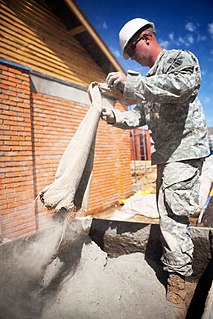
A cement is a binder, a substance used for construction that sets, hardens, and adheres to other materials to bind them together. Cement is seldom used on its own, but rather to bind sand and gravel (aggregate) together. Cement mixed with fine aggregate produces mortar for masonry, or with sand and gravel, produces concrete. Cement is the most widely used material in existence and is only behind water as the planet's most-consumed resource.

Jena is a German university city and the second largest city in Thuringia. Together with the nearby cities of Erfurt and Weimar, it forms the central metropolitan area of Thuringia with approximately 500,000 inhabitants, while the city itself has a population of about 110,000. Jena is a centre of education and research; the Friedrich Schiller University was founded in 1558 and had 18,000 students in 2017 and the Ernst-Abbe-Fachhochschule Jena counts another 5,000 students. Furthermore, there are many institutes of the leading German research societies.
From 1928 to 1943, the tower was the seat of the editorship and publishing house of the Stuttgarter Neues Tagblatt, a local newspaper; the building derives its name from this original tenant. After World War II until 1978, the tower served as the headquarters for the two newspapers Stuttgarter Zeitung and the Stuttgarter Nachrichten. In 2004, after extensive renovations, the tower was converted into a cultural center with several theatres under the name Kultur unterm Turm.

World War II, also known as the Second World War, was a global war that lasted from 1939 to 1945. The vast majority of the world's countries—including all the great powers—eventually formed two opposing military alliances: the Allies and the Axis. A state of total war emerged, directly involving more than 100 million people from over 30 countries. The major participants threw their entire economic, industrial, and scientific capabilities behind the war effort, blurring the distinction between civilian and military resources. World War II was the deadliest conflict in human history, marked by 50 to 85 million fatalities, most of whom were civilians in the Soviet Union and China. It included massacres, the genocide of the Holocaust, strategic bombing, premeditated death from starvation and disease, and the only use of nuclear weapons in war.
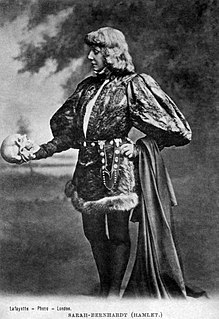
Theatre or theater is a collaborative form of fine art that uses live performers, typically actors or actresses, to present the experience of a real or imagined event before a live audience in a specific place, often a stage. The performers may communicate this experience to the audience through combinations of gesture, speech, song, music, and dance. Elements of art, such as painted scenery and stagecraft such as lighting are used to enhance the physicality, presence and immediacy of the experience. The specific place of the performance is also named by the word "theatre" as derived from the Ancient Greek θέατρον, itself from θεάομαι.





